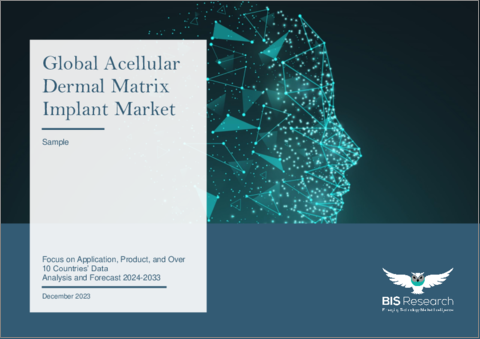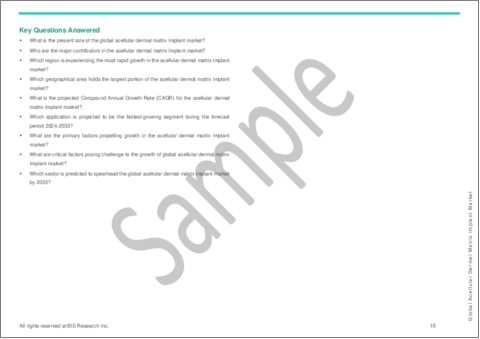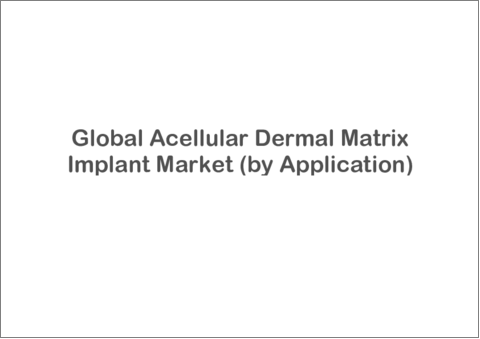|
|
市場調査レポート
商品コード
1389928
無細胞真皮マトリックス (ADM) インプラント:世界および地域市場の分析・予測 (2024-2030年)Acellular Dermal Matrix Implant Market - A Global and Regional Analysis - Analysis and Forecast, 2024-2030 |
||||||
カスタマイズ可能
適宜更新あり
|
|||||||
| 無細胞真皮マトリックス (ADM) インプラント:世界および地域市場の分析・予測 (2024-2030年) |
|
出版日: 2023年12月05日
発行: BIS Research
ページ情報: 英文
納期: 7~10営業日
|
- 全表示
- 概要
- 目次
世界の無細胞真皮マトリックス (ADM) インプラントの市場規模は、2030年には10億米ドルを超える規模に成長すると予測されています。
同市場は、組織の再生と再建を必要とする火傷、創傷、感染症などの慢性疾患の有病率の増加によって牽引されています。さらに、ADMインプラントはさまざまな低侵襲処置に使用できるため、低侵襲処置に対する需要の高まりがADMインプラントの需要を促進しています。
タイプ別では、生体適合性と拒絶反応のリスクの低さから、ヒトの皮膚の部門が最大のシェアを占めると予想されています。また、用途別では、形成外科手術におけるADMの用途が広いことから、形成外科の部門が最大のシェアを占めると予想されています。さらに、地域別では、北米地域が慢性疾患の有病率が高く、ヘルスケアインフラが発達していることから、最大のシェアを占める見通しです。一方、アジアは同地域におけるADMの需要増加により、最も急成長する市場になると予想されています。
当レポートでは、世界の無細胞真皮マトリックス (ADM) インプラントの市場を調査し、市場の背景・概要、市場成長への各種影響因子の分析、R&D動向、法規制環境、市場規模の推移・予測、各種区分・地域/主要国別の詳細分析、競合情勢、主要企業の分析などをまとめています。
目次
第1章 市場:業界の展望
- 動向:現在および将来の影響評価
- サプライチェーンの概要
- バリューチェーン分析
- マーケットマップ
- 価格予測
- R&Dレビュー
- 国・企業別の特許出願動向
- 規制状況
- ステークホルダーの分析
- 使用事例
- エンドユーザーと購入基準
- 市場力学の概要
- 市場促進要因
- 市場抑制要因
- 市場機会
- スタートアップ資金調達:サマリー
第2章 無細胞真皮マトリックス (ADM) インプラント市場:用途別
- 用途の分類
- 用途の概要
- 形成外科
- 乳房再建
- 顔面再建
- 腹部形成術
- その他
- 婦人科
- 腹圧性尿失禁
- 骨盤臓器脱
- 膣瘻再建
- その他
- その他
- 創傷治癒
- 火傷修復
- 歯科
- 整形外科
第3章 無細胞真皮マトリックス (ADM) インプラント市場:製品タイプ別
- 製品の分類
- 製品概要
- ヒトの皮膚
- 同種異系
- 自己由来
- 動物の皮膚
- ブタ
- ウシ
- その他
第4章 無細胞真皮マトリックス (ADM) インプラント市場:地域別
- 地域概要
- 促進要因・抑制要因
- 北米
- 市場
- 用途
- 製品
- 国別
- 欧州
- 市場
- 用途
- 製品
- 国別
- アジア太平洋
- 市場
- 用途
- 製品
- 国別
第5章 市場:競合情勢・企業プロファイル
- 競合情勢
- 企業プロファイル
- Zimmer Biomet
- Allergan
- Stryker
- MTF Biologics
- LifeNet Health
- Integra LifeSciences
- Medtronic
- Arthrex
- Straumann
- Wright Medical Group
- Hans Biomed
- Xtant Medical
第6章 成長機会・提言
第7章 調査手法
The global acellular dermal matrix (ADM) implants market is expected to cross $1 billion by 2030. ADMs are scaffolds derived from animal or human skin that are used to regenerate and reinforce damaged tissues. They are commonly used in plastic surgery, gynecology, and other reconstructive procedures.
The global acellular dermal matrix (ADM) implants market is driven by the increasing prevalence of chronic conditions such as burns, wounds, and infections, which require tissue regeneration and reconstruction. Additionally, the growing demand for minimally invasive procedures is driving the demand for ADM implants, as they can be used in a variety of minimally invasive procedures.
The global acellular dermal matrix (ADM) implants market is segmented by type, application, and region. By type, the human skin segment is expected to hold the largest market share due to its biocompatibility and low risk of rejection. By application, the plastic surgery segment is expected to hold the largest market share due to the wide range of applications of ADMs in plastic surgery procedures.
North America is expected to hold the largest market share due to the high prevalence of chronic conditions and the well-developed healthcare infrastructure in the region. However, Asia is expected to be the fastest-growing market due to the increasing demand for ADMs in the region.
The ADM implants market is characterized by the presence of both large multinational corporations and smaller regional players.
Some of the key players in the market include:
|
|
These companies are engaged in research and development to expand their product offerings and improve the performance of their ADMs. They are also actively pursuing strategic partnerships and acquisitions to expand their market reach and strengthen their competitive positions.
Table of Contents
1. Markets: Industry Outlook
- 1.1. Trends: Current and Future Impact Assessment
- 1.2. Supply Chain Overview
- 1.2.1. Value chain Analysis
- 1.2.2. Market Map
- 1.2.3. Pricing Forecast
- 1.3. R&D Review
- 1.3.1. Patent Filing Trend by Country, by Company
- 1.4. Regulatory Landscape
- 1.5. Stakeholder Analysis
- 1.5.1. Use Case
- 1.5.2. End User and buying criteria
- 1.6. Market Dynamics Overview
- 1.6.1. Market Drivers
- 1.6.2. Market Restraints
- 1.6.3. Market Opportunities
- 1.7. Startup Funding Summary
2. Acellular Dermal Matrix Implants Market by Application
- 2.1. Application Segmentation
- 2.2. Application Summary
- 2.3. Plastic Surgery
- 2.3.1. Breast Reconstruction
- 2.3.2. Facial Reconstruction
- 2.3.3. Abdominoplasty
- 2.3.4. Other
- 2.4. Gynecology
- 2.4.1. Stress Urinary Incontinence
- 2.4.2. Pelvic Organ Prolapse
- 2.4.3. Reconstruction of Vaginal Fistulas
- 2.4.4. Other
- 2.5. Others
- 2.5.1. Wound Healing
- 2.5.2. Burn Repair
- 2.5.3. Dental Applications
- 2.5.4. Orthopedic Applications
3. Acellular Dermal Matrix Implants Market by Product Type
- 3.1. Product Segmentation
- 3.2. Product Summary
- 3.3. Human Skin
- 3.3.1. Allogenic
- 3.3.1.1. Dermal Matrix
- 3.3.1.2. Fat Grafts
- 3.3.2. Autologous
- 3.3.2.1. Dermal Matrix
- 3.3.2.2. Fat Grafts
- 3.3.1. Allogenic
- 3.4. Animal Skin
- 3.4.1. Porcine
- 3.4.2. Bovine
- 3.4.3. Other
4. Acellular Dermal Matrix Implants Market by Region
- 4.1. Regional Summary
- 4.2. Drivers and Restraints
- 4.3. North America
- 4.3.1. Markets
- 4.3.1.1. Key Market Participants in North America
- 4.3.1.2. Business Drivers
- 4.3.1.3. Business Challenges
- 4.3.2. Application
- 4.3.3. Product
- 4.3.4. North America by Country
- 4.3.4.1. U.S.
- 4.3.4.2. Canada
- 4.3.1. Markets
- 4.4. Europe
- 4.4.1. Markets
- 4.4.1.1. Key Market Participants in Europe
- 4.4.1.2. Business Drivers
- 4.4.1.3. Business Challenges
- 4.4.2. Application
- 4.4.3. Product
- 4.4.4. Europe by Country
- 4.4.4.1. U.K.
- 4.4.4.2. Germany
- 4.4.4.3. France
- 4.4.1. Markets
- 4.5. Asia-Pacific
- 4.5.1. Markets
- 4.5.1.1. Key Market Participants in Asia-Pacific
- 4.5.1.2. Business Drivers
- 4.5.1.3. Business Challenges
- 4.5.2. Application
- 4.5.3. Product
- 4.5.4. Asia-Pacific by Country
- 4.5.4.1. China
- 4.5.4.2. Japan
- 4.5.4.3. India
- 4.5.1. Markets
5. Markets - Competitive Landscape & Company Profiles
- 5.1. Competitive Landscape
- 5.2. Company Profiles
- 5.2.1. Zimmer Biomet
- 5.2.1.1. Company Overview
- 5.2.1.2. Top Products / Product Portfolio
- 5.2.1.3. Top Competitors
- 5.2.1.4. Target Customers /End-Users
- 5.2.1.5. Key Personnel
- 5.2.1.6. Market Share
- 5.2.1.7. Analyst View
- 5.2.2. Allergan
- 5.2.2.1. Company Overview
- 5.2.2.2. Top Products / Product Portfolio
- 5.2.2.3. Top Competitors
- 5.2.2.4. Target Customers /End-Users
- 5.2.2.5. Key Personnel
- 5.2.2.6. Market Share
- 5.2.2.7. Analyst View
- 5.2.3. Stryker
- 5.2.3.1. Company Overview
- 5.2.3.2. Top Products / Product Portfolio
- 5.2.3.3. Top Competitors
- 5.2.3.4. Target Customers /End-Users
- 5.2.3.5. Key Personnel
- 5.2.3.6. Market Share
- 5.2.3.7. Analyst View
- 5.2.4. MTF Biologics
- 5.2.4.1. Company Overview
- 5.2.4.2. Top Products / Product Portfolio
- 5.2.4.3. Top Competitors
- 5.2.4.4. Target Customers /End-Users
- 5.2.4.5. Key Personnel
- 5.2.4.6. Market Share
- 5.2.4.7. Analyst View
- 5.2.5. LifeNet Health
- 5.2.5.1. Company Overview
- 5.2.5.2. Top Products / Product Portfolio
- 5.2.5.3. Top Competitors
- 5.2.5.4. Target Customers /End-Users
- 5.2.5.5. Key Personnel
- 5.2.5.6. Market Share
- 5.2.5.7. Analyst View
- 5.2.6. Integra LifeSciences
- 5.2.6.1. Company Overview
- 5.2.6.2. Top Products / Product Portfolio
- 5.2.6.3. Top Competitors
- 5.2.6.4. Target Customers /End-Users
- 5.2.6.5. Key Personnel
- 5.2.6.6. Market Share
- 5.2.6.7. Analyst View
- 5.2.7. Medtronic
- 5.2.7.1. Company Overview
- 5.2.7.2. Top Products / Product Portfolio
- 5.2.7.3. Top Competitors
- 5.2.7.4. Target Customers /End-Users
- 5.2.7.5. Key Personnel
- 5.2.7.6. Market Share
- 5.2.7.7. Analyst View
- 5.2.8. Arthrex
- 5.2.8.1. Company Overview
- 5.2.8.2. Top Products / Product Portfolio
- 5.2.8.3. Top Competitors
- 5.2.8.4. Target Customers /End-Users
- 5.2.8.5. Key Personnel
- 5.2.8.6. Market Share
- 5.2.8.7. Analyst View
- 5.2.9. Straumann
- 5.2.9.1. Company Overview
- 5.2.9.2. Top Products / Product Portfolio
- 5.2.9.3. Top Competitors
- 5.2.9.4. Target Customers /End-Users
- 5.2.9.5. Key Personnel
- 5.2.9.6. Market Share
- 5.2.9.7. Analyst View
- 5.2.10. Wright Medical Group
- 5.2.10.1. Company Overview
- 5.2.10.2. Top Products / Product Portfolio
- 5.2.10.3. Top Competitors
- 5.2.10.4. Target Customers /End-Users
- 5.2.10.5. Key Personnel
- 5.2.10.6. Market Share
- 5.2.10.7. Analyst View
- 5.2.11. Hans Biomed
- 5.2.11.1. Company Overview
- 5.2.11.2. Top Products / Product Portfolio
- 5.2.11.3. Top Competitors
- 5.2.11.4. Target Customers /End-Users
- 5.2.11.5. Key Personnel
- 5.2.11.6. Market Share
- 5.2.11.7. Analyst View
- 5.2.12. Xtant Medical
- 5.2.12.1. Company Overview
- 5.2.12.2. Top Products / Product Portfolio
- 5.2.12.3. Top Competitors
- 5.2.12.4. Target Customers /End-Users
- 5.2.12.5. Key Personnel
- 5.2.12.6. Market Share
- 5.2.12.7. Analyst View
- 5.2.1. Zimmer Biomet






